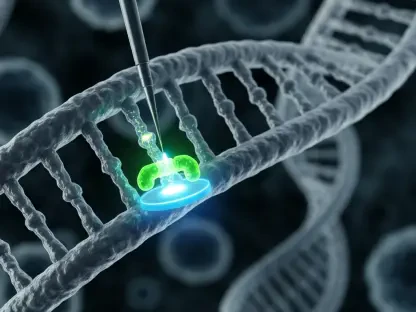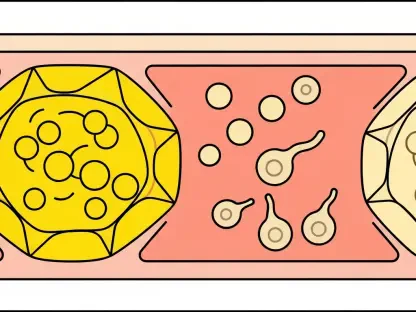In a world where breast cancer claims countless lives each year, a staggering statistic emerges: over 70% of cases are estrogen receptor-positive (ER+), making them particularly challenging to treat due to their ability to adapt and resist therapies. Imagine a microscopic battlefield within the body, where these cancer cells face hostile conditions like low oxygen and nutrient scarcity—yet somehow, they not only endure but thrive. What secret weapon allows them to defy such stress? A groundbreaking discovery from researchers at The Rockefeller University unveils a molecular trick that could change the landscape of cancer treatment forever.
Uncovering a Hidden Survival Strategy in Breast Cancer Cells
Deep within the cellular machinery of breast cancer, a startling mechanism has come to light. ER+ breast cancer cells, which rely on estrogen to grow, have developed a way to flip a molecular switch that enables survival under the harshest conditions. This revelation points to a protein subunit known as MED1, part of a larger complex that controls gene activity, as the key player in this deadly game of adaptation. The implications of this finding ripple through the scientific community, offering a glimpse into why some tumors persist despite aggressive treatments.
This survival tactic is not just a random quirk of nature. It represents a deliberate reprogramming of cellular behavior, allowing cancer cells to turn environmental stress into a growth advantage. Unlike healthy cells that falter under similar pressures, these malignant cells exploit their surroundings, fueling tumor expansion and spread. Such resilience underscores the urgency of understanding this process at a molecular level to outsmart cancer’s defenses.
The Critical Role of Stress Survival in Battling Breast Cancer
Breast cancer remains one of the leading causes of death among women globally, with ER+ variants accounting for a significant majority of diagnoses. These cells often inhabit tumor microenvironments that are hostile, marked by conditions like hypoxia and oxidative stress, which would typically destroy normal tissue. Yet, their ability to adapt to such adversity makes them formidable foes, often rendering standard therapies less effective over time.
This adaptability is not merely a biological curiosity; it’s a critical barrier to successful treatment. As drug resistance continues to plague clinical outcomes, identifying how cancer cells withstand stress becomes paramount. The discovery of a specific mechanism tied to MED1 offers a potential chink in their armor, providing hope for developing targeted interventions that could save millions of lives.
Breaking Down the MED1 Switch: A Game-Changing Mechanism
At the heart of this survival strategy lies the MED1 subunit, a component of the Mediator complex that orchestrates gene transcription in cells. In ER+ breast cancer, MED1 acts as a linchpin, enabling the cells to rewrite their genetic playbook when faced with stress. Under conditions like low oxygen or nutrient deprivation, these cells adjust gene expression to not only survive but also to accelerate tumor growth, defying expectations of cellular collapse.
The process hinges on a biochemical toggle involving acetylation, a modification that alters protein function. Research has shown that a protein called SIRT1 deacetylates MED1 during stress, stripping away acetyl groups to strengthen its interaction with RNA polymerase II, an enzyme crucial for gene transcription. This interaction sparks the activation of protective genes, arming cancer cells against hostile conditions and enhancing their proliferation.
Experimental evidence further solidifies this mechanism’s significance. Using advanced CRISPR technology, scientists created a mutant MED1 lacking specific acetylation sites, effectively mimicking the deacetylated state. When introduced into ER+ breast cancer cells, these mutants led to faster-growing, stress-resistant tumors, proving that this molecular switch is a powerful tool in cancer’s arsenal.
Expert Voices on a Transformative Discovery
Lead researcher Robert Roeder from The Rockefeller University highlights the broader impact of this finding, stating, “This mechanism aligns with a larger pattern where acetylation controls key transcription factors, similar to what’s been observed with proteins like p53.” His perspective frames the MED1 switch as part of a widespread regulatory system that cancer manipulates to its advantage. Such insights emphasize the potential of targeting this pathway across various cancer types.
First author Ran Lin offers a vivid analogy, describing the acetylation-deacetylation process as “a regulatory switch that cancer cells hijack to rewire their stress response.” This personal take, combined with rigorous data published in a leading scientific journal, underscores the credibility of the research. The expert consensus points to MED1 as a promising focal point for disrupting cancer’s survival tactics, opening new avenues for therapeutic exploration.
Charting New Paths for Breast Cancer Treatment
The implications of this discovery pave the way for innovative treatment strategies. One potential approach involves designing drugs to block SIRT1-mediated deacetylation of MED1, which could prevent cancer cells from activating their protective genes under stress. Such inhibitors might weaken tumor resilience, halting growth and making existing therapies more effective.
Another direction lies in personalizing care for ER+ breast cancer patients. By identifying biomarkers linked to high MED1 activity, clinicians could tailor treatments to disrupt this specific pathway, improving patient outcomes. This precision medicine approach holds promise for addressing individual variations in disease progression and response to therapy.
Lastly, combining MED1-targeting agents with current treatments like hormone therapy could tackle the pervasive issue of drug resistance. Integrating these novel interventions with established protocols might create a synergistic effect, offering a more comprehensive attack on cancer. These strategies, rooted in cutting-edge research, provide a roadmap for transforming how breast cancer is managed in clinical settings.
Reflecting on a Milestone in Cancer Research
Looking back, the unveiling of the MED1 switch marked a pivotal moment in understanding how breast cancer cells endured stress. It highlighted a previously hidden layer of cellular cunning that had long confounded medical efforts. The insights gained from this work laid a foundation for rethinking therapeutic approaches, emphasizing the power of basic science in solving complex health challenges.
As a next step, the scientific community turned its focus toward developing targeted drugs that could interrupt this molecular mechanism. Collaborative efforts between researchers and pharmaceutical innovators aimed to translate these findings into tangible treatments within the coming years, from 2025 onward. This momentum promised to bring renewed hope to patients battling ER+ breast cancer, driving the fight against this disease into a new era of precision and possibility.









